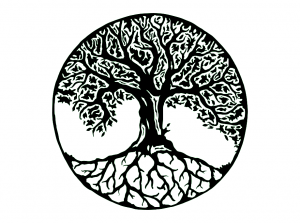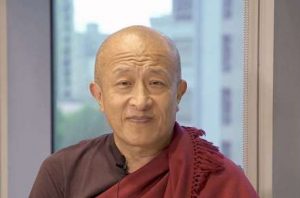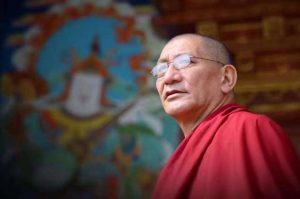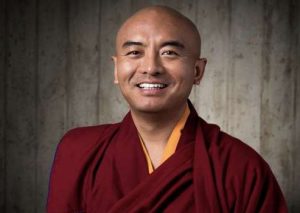
A buddha’s intent: to deliver all sentient beings to become a buddha
Although people may have different reasons for wanting to study and practice Buddhism, Shakyamuni Buddha, Amitabha Buddha, and all other buddhas have only one reason for propagating the Buddhist teachings: to deliver all sentient beings so that they may become buddhas. In other words, ultimate emancipation!
There are three milestones for an ordinary being who resolves to become a buddha and attain perfect enlightenment. The first is to liberate oneself from the cycle of birth and death and leave the Three Domains in the Saha World. This means that one has exited the cycle of reincarnation within the Six Realms.
Passing this first milestone, the practitioner becomes a sagely being or bodhisattva who aims to reach the second milestone: dwelling in the state of non-retrogression. This is also called entering the Definitely Assured State (karma of assurance to attain buddhahood) or achieving the perseverance of no-birth. When a bodhisattva reaches the second milestone, he dwells in the status of the Eighth Bhumi, the 48th of the 52 stages before becoming a buddha.
What is the third milestone before the practitioner can become a buddha? A bodhisattva of the 51st stage is known as Equal Enlightenment, also known as “Dwelling in the Stage of Becoming a Buddha after One More Life,” like Maitreya Bodhisattva. Through self-power practice, the practitioner needs to take at least one Great Asamkhyakalpa to reach each milestone, so one takes three Great Asamkhyakalpas in total before one becomes a buddha!
The Pure Land teaching is the easy path to unfailingly becoming a buddha
Nagarjuna Bodhisattva writes in the Chapter of Easy Practice: “There are infinite gates to get access to the Buddhist teachings, just like taking trips in the world, some difficult and some easy. If we take a land trip by walking it is painful, but if we take a sea trip by boat, it is joyful. It is similar in the path of bodhisattvas.”
In the path of bodhisattvas, the difficult path refers to the “self-powered” practices of precepts, meditation, and wisdom, and the easy path refers to the “other-powered” practice of recitation of the Buddha’s name. The former is like taking a land trip by walking and the latter is like a cruise trip by sailing.
Nagarjuna further writes: “Some practice diligently with vigor, but some devote themselves to easy practice with faith as an expedient means, thus reaching the state of Avinivartaniya.” The state of Avinivartaniya means reaching the second milestone in the process of becoming a buddha.
For the easy path, the practitioner relies on the Buddha’s power, so he must entrust himself to the Buddha. This is why Nagarjuna Bodhisattva states that he “devotes himself to easy practice with faith as an expedient means.” Thus, the practitioner should humbly listen and obey what the Buddha advises him to do.
The 18th and 11th vows enable us to reach the firsttwo milestones
Referring to Amitabha’s 48 vows, Master Tanluan identified three vows that enable all inhabitants in the Land of Bliss to reach the three milestones through recourse to Amitabha’s vow power. They are the 18th Vow, the 11th Vow, and the 22nd Vow, respectively.
The 18th Vow states:
If, when I attain Buddhahood, sentient beings in the lands of the ten quarters who sincerely and joyfully entrust themselves to me, desire to be born in my land, and call my Name, even ten times, should not be born there, may I not attain perfect Enlightenment.
By rebirth in Amitabha’s reward land through his perfect and complete merit and virtues, a sentient being will liberate himself from the cycle of birth and death in Three Domains and the Six Realms in the Land of Saha, the first milestone.
The 11th Vow states:
If, when I attain Buddhahood, humans and devas in my land should not dwell in the Definitely Assured State and unfailingly reach Nirvana, may I not attain perfect Enlightenment.
As Amitabha Buddha has attained perfect Enlightenment, he has the full capacity to enable all humans and devas in his Land of Bliss to dwell in the Definitely Assured State. This means their attainment of Nirvana, or perfect enlightenment, is a certainty, the second milestone.
The 22nd Vow enables us to reach the third milestone and to become a buddha
The 22nd Vow states:
If, when I attain Buddhahood, bodhisattvas in the Buddhalands of other quarters who visit my land should not ultimately and unfailingly reach the Stage of Becoming a Buddha after One More Life, may I not attain perfect Enlightenment. Excepted are those who wish to teach and guide sentient beings in accordance with their original vows. The inhabitants of the Pure Land reach the Stage of Becoming a Buddha after One More Life. However, they also leave the Land of Bliss, and go to other worlds that have no Buddha to teach and guide sentient beings. In this way, they fulfill their original vows.
The 22nd Vow states:
For they wear the armour of great vows, accumulate merits, deliver all beings from birth-and-death, visit Buddha-lands to perform the bodhisattva practices, make offerings to Buddhas, Tathagatas, throughout the ten quarters, enlighten uncountable sentient beings as numerous as the sands of the River Ganges, and establish them in the highest, perfect Enlightenment.
This part of the vow talks about the preparation for delivering sentient beings in other worlds, which is what Shakyamuni Buddha did before he became a buddha in our world, as told in the Infinite Life Sutra. Lastly, the 22nd Vow states:
Such bodhisattvas transcend the course of practice of the ordinary bodhisattvas, manifest the practices of all the bodhisattva stages, and cultivate the virtues of universal benevolences.
This means that, through rebirth in the Land of Bliss, all sentient beings, including ordinary beings like us, can, with recourse to Amitabha’s vow power, transcend all three milestones simultaneously and unfailingly to become a Buddha. Isn’t it inconceivable?
Related features from BDG
Expressing the Form of Amitabha Buddha as “Light”
The Body’s Appearance Upon Rebirth in the Land of Bliss
Why Did Amitabha Buddha Make the 19th and 20th Vows for Sentient Beings Who Aspire to Be Reborn in the Land of Bliss?













